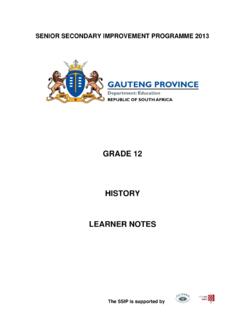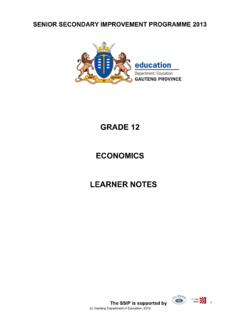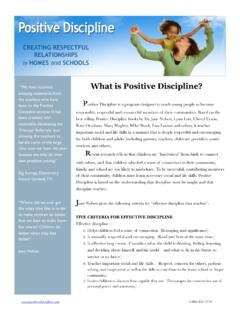Transcription of GRADE 12 LIFE SCIENCES LEARNER NOTES
1 SENIOR SECONDARY INTERVENTION PROGRAMME 2013. GRADE 12. life SCIENCES . LEARNER NOTES . The SSIP is supported by TABLE OF CONTENTS. LEARNER NOTES . SESSION TOPIC PAGE. 1 1. Nucleic acids DNA and RNA printing 3 - 13. 2. Protein synthesis and DNA fingerprinting 14 - 24. 2 1. Meiosis 25 35. 2. Genetics terms 36 47. 2 1. Consolidation exercises meiosis and DNA 48 50. Self Study Consolidation exercises meiosis and fingerprinting 51 - 55. Page 2 of 55. GAUTENG DEPARTMENT OF EDUCATION SENIOR SECONDARY INTERVENTION PROGRAMME. life SCIENCES GRADE 12 SESSION 1 ( LEARNER NOTES ). SESSION 1: TOPIC 1: NUCLEIC ACIDS DNA AND RNA.
2 LEARNER Note: Please ensure that you understand that the nucleus is an organelle located in a cell. Go through the structure of DNA and RNA very carefully. You MUST understand the structure and combination of the complimentary bases or you will not be able to answer exam questions based on Protein Synthesis. REMEMBER: Thymine is only in DNA and Uracil is only in RNA. SECTION A: TYPICAL EXAM QUESTIONS. QUESTION 1: 16 minutes (Taken from DoE Exemplar 2008). HINTS: The structure of the DNA and RNA molecule is very important and is often examined. Make sure that you know the labels of each component.
3 Remember to label the diagram first and then move onto the questions The diagram below represents a part of a molecule. Study the diagram and answer the questions that follow. Identify the molecule in the above diagram. (1). Label the parts numbered 1 and 5 respectively. (2). What is the collective name for the parts numbered 2, 3 and 4? (1). What is the significance of this molecule being able to replicate itself? (2). (Replicate means to make another identical molecule to copy'). Page 3 of 55. GAUTENG DEPARTMENT OF EDUCATION SENIOR SECONDARY INTERVENTION PROGRAMME.
4 life SCIENCES GRADE 12 SESSION 1 ( LEARNER NOTES ). The following questions are based on protein synthesis. Describe each of the following: (You must learn the definitions.). (a) Transcription (2). (b) Translation (2). The diagram below shows the sequence of nitrogenous bases of a strand of DNA which codes for part of a protein molecule. Write down the mRNA codon sequence that reads from left to right from the DNA. sequence above. (3). (Remember that the mRNA codon will always be opposite to the DNA code. Also remember that Thymine is only found on DNA and that on RNA Thymine is replaced with Uracil).
5 The following diagram shows the anticodons of nine different tRNA (transfer RNA). molecules each carrying a particular amino acid. (The anti-codon is the opposite to the mRNA and is, therefore, the same as what was coded on the DNA). Select and write down from the above diagram, the amino acids (in the correct sequence). that would be required for the base sequence of mRNA shown below. (3). [16]. Page 4 of 55. GAUTENG DEPARTMENT OF EDUCATION SENIOR SECONDARY INTERVENTION PROGRAMME. life SCIENCES GRADE 12 SESSION 1 ( LEARNER NOTES ). QUESTION 2: 8minutes (Taken from DoE November 2009).
6 The table below shows the DNA base triplets that code for different amino acids. The following is a part of a sequence of amino acids that form a particular protein molecule: (A reminder that a codon is made up of 3 bases and can also be called a triplet base). Name the process by which mRNA is formed from a DNA template. (1). How many mRNA codons would be involved in forming the portion of protein shown above? (1). Write down the sequence of the first THREE mRNA codons (from left to right). for this portion of the protein. (3). The following is a sequence of base triplets in DNA: GAA - GTA - TTT - AAA.
7 (a) If guanine, found in the first base triplet, is removed, explain how this would affect the structure of the protein. (2). (b) Name the process that occurs when the sequence of bases in DNA changes. (1). [8]. Page 5 of 55. GAUTENG DEPARTMENT OF EDUCATION SENIOR SECONDARY INTERVENTION PROGRAMME. life SCIENCES GRADE 12 SESSION 1 ( LEARNER NOTES ). QUESTION 3: 11 minutes (Taken from DoE Preparatory Exam 2008). (A reminder first to label the diagram and then to move on to questions). Study the diagram illustrating protein synthesis below, and answer the questions that follow.
8 Label the molecules indicated by 2 and 3. (2). Using the letters of the genetic code, write down the complementary nitrogenous bases on strand 1 of the DNA double helix, starting from the top. (3). (Remember: A=T/U and G=C). Use the table below to determine which three amino acids in the diagram are represented by 4, 5 and 6. (3 x 2) (6). THE RELATIONSHIP BETWEEN tRNA AND AMINO ACIDS DUTING PROTEIN. SYNTHESIS. tRNA anticodons Amino acid UGU threoline CGU alanine UUU lysine ACA cysteine GCA arginine GUU glutamine CUA aspartate CCA glycine AAA phenylalanine [11]. Page 6 of 55.
9 GAUTENG DEPARTMENT OF EDUCATION SENIOR SECONDARY INTERVENTION PROGRAMME. life SCIENCES GRADE 12 SESSION 1 ( LEARNER NOTES ). QUESTION 4: 5 minutes ( to taken from Bishops Prelim 2008 and to taken from FS DoE prelim 2008). The first of the accompanying diagrams shows a small part of the DNA molecule where the four types of base molecules are represented by the letters A, T, C. and G. Which of the following supplies the information missing from Box X. in the first diagram? Sally carries the gene pairs AA, Bb and Dd on different chromosome pairs. Which one of her egg cells could contain the following genes: A abd?
10 B ABDd? C AbD? D AA Bb Dd? Page 7 of 55. GAUTENG DEPARTMENT OF EDUCATION SENIOR SECONDARY INTERVENTION PROGRAMME. life SCIENCES GRADE 12 SESSION 1 ( LEARNER NOTES ). The graph below shows changes in the amount of DNA per cell in a series of cellular events in a mammal. Which one of the following combinations correctly describes the events shown on the graph? I II III IV. A DNA Replication Mitosis Meiosis Fertilisation B DNA Replication Meiosis 1 Meiosis 2 Fertilisation C Fertilisation Meiosis Mitosis DNA Replication D Mitosis Meiosis 1 Meiosis 2 DNA Replication In analysing the number of different bases in a DNA sample, the following result would be consistent with the base-pairing rules: A.
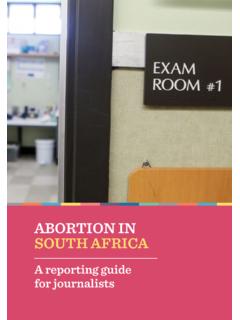
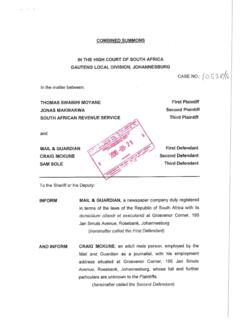
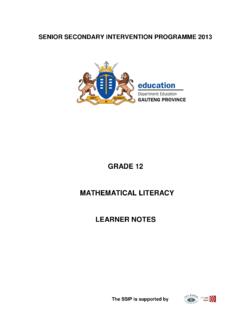
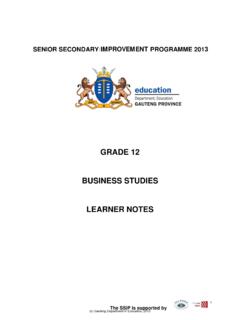

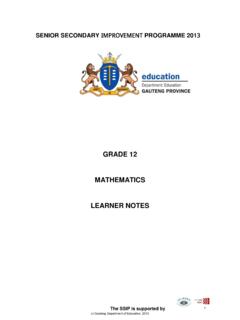
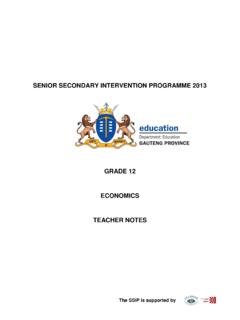
![FORM B NOTICE OF INTERNAL APPEAL [Regulation 8]](/cache/preview/a/0/a/7/3/c/7/0/thumb-a0a73c70e115f1c5cc7bd639b8e458e6.jpg)
